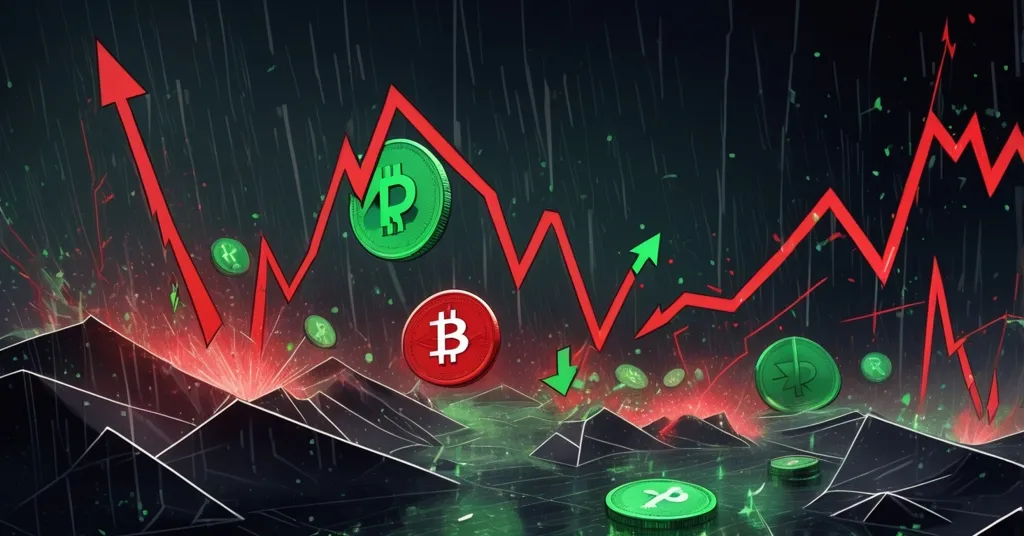Crypto Crash: XRP Death Cross Nears, Ethereum Risks $2,000, Cardano Sinks Further

Crypto Crash Alert: XRP Death Cross Looms, Ethereum Faces Price Drop, Cardano Sinks Deeper
Crypto investors are sweating bullets as the market takes a savage beating, with XRP teetering on the edge of a dreaded death cross, Ethereum fighting to avoid a brutal slide to $2,000, and Cardano looking like a technical trainwreck in extreme oversold territory. Let’s slice through the chaos and analyze the bearish setups, institutional moves, and faint glimmers of hope in this bloodbath of a market.
- XRP’s Bearish Signal: A death cross could hit within a week, pointing to long-term downside.
- Ethereum’s Fragile Hold: ETH risks a steep fall to $2,000 if support crumbles.
- Cardano’s Despair: ADA is oversold with a full technical breakdown, hinting at more pain.
XRP: Death Cross Danger Zone
XRP is walking a tightrope over a bearish abyss, with a death cross—a chilling technical indicator—potentially just days away. For those new to crypto trading, a death cross happens when the 50-day moving average, which tracks short-term price trends, crosses below the 200-day moving average, a longer-term benchmark. Think of it as the market’s mood swinging from bad to worse, often signaling a prolonged downturn. Currently trading at around $2.29 after a 2% drop in the last 24 hours, XRP is getting slammed. Resistance stands firm as a brick wall at $2.60-$2.70, a level it can’t seem to crack, while support dangles precariously at $2.00. If this death cross confirms within the week, we could see XRP tumble to $1.85 or even $1.60—levels not seen in ages that would spook even the most stubborn holders.
Adding insult to injury, institutional players are piling on the pessimism. A recently funded wallet on Hyperliquid, a derivatives trading platform, opened a jaw-dropping $7 million 20x leveraged short position against XRP. For the uninitiated, a leveraged short is a high-stakes bet where traders borrow funds to wager on a price drop, magnifying both gains and losses. This isn’t a casual gamble; it’s a calculated move by big money expecting a nosedive, and it’s putting extra downward pressure on XRP. Historically, XRP has weathered similar bearish patterns, like during the 2018 crypto winter when a death cross preceded a months-long decline. Could history repeat itself? Possibly, especially with trading volume down and no bullish catalysts in sight. And let’s not forget the ongoing Ripple vs. SEC legal saga, which continues to haunt investor confidence—every court update feels like a coin toss for XRP’s future. For more on the latest market predictions surrounding XRP and other cryptos, check out this detailed analysis of XRP’s looming death cross and Ethereum’s struggles.
That said, it’s not all doom. A surprise resolution in Ripple’s favor with the SEC could spark a rally, flipping the script on this bearish setup. While the odds seem slim given the current market vibe, stranger things have happened in crypto. For now, though, XRP’s chart looks like it’s auditioning for a horror flick, and most traders are bracing for impact.
Ethereum: Teetering on the Brink
While XRP battles its demons, Ethereum, the heavyweight of smart contracts, isn’t exactly basking in glory either. Trading at roughly $3,600 after shedding 1.7% in the last 24 hours, ETH has already lost its 200-day moving average—a critical long-term trendline that often separates bull from bear territory. Resistance looms like a distant mirage at $4,000-$4,200, while immediate support clings to life between $3,500 and $3,600. If this floor gives way, the next stops could be $3,000 or the psychologically crushing $2,000 mark—a level that would trigger a mass panic sell-off among even the most die-hard HODLers. Weekly trading volume for Ethereum has reportedly slumped by nearly 30%, signaling fading interest and weak hands bailing out.
Ethereum isn’t just a cryptocurrency; it’s the backbone of decentralized finance (DeFi) and non-fungible tokens (NFTs), powering thousands of apps through smart contracts—self-executing agreements coded on the blockchain. But despite its pivotal role, persistent challenges like sky-high gas fees (the cost of transactions) and scaling bottlenecks continue to frustrate users and dent confidence. Even post-Merge, which shifted Ethereum to a more energy-efficient proof-of-stake system, the network struggles to keep up with demand. Compare this to the 2022 bear market, where ETH dipped below $1,000 amid similar technical breakdowns; a drop to $2,000 now wouldn’t be unprecedented, but it’d still sting. Without fresh buying pressure, Ethereum’s fight for survival looks grim.
Yet, there’s a sliver of hope. Upcoming upgrades, like progress on sharding—a method to split the blockchain into smaller, faster pieces—could reignite investor interest if rolled out successfully. A sudden spike in DeFi activity or positive regulatory news could also push ETH back above $3,800, staving off disaster. Still, with the broader altcoin market bleeding and no immediate catalysts, Ethereum’s tightrope walk feels more like a misstep waiting to happen.
Cardano: A Technical Trainwreck
Cardano, or ADA, is in an even uglier mess, with its price charts screaming disaster. Trading at about $0.53 after losing over 2% in the last 24 hours, ADA is flashing every bearish signal known to traders. Its Relative Strength Index (RSI), a tool measuring momentum on a scale of 0 to 100, sits at a pitiful 31—deep in oversold territory. Normally, an RSI this low might hint at a bargain, tempting buyers to scoop up cheap coins expecting a bounce. But don’t get your hopes up. Cardano’s technicals are a complete wreck, showing a death cross alignment across multiple key moving averages, from the 20-day to the 200-day. This isn’t a temporary dip; it’s a profound loss of momentum. If ADA can’t claw back to the $0.60-$0.65 range soon, further slides to $0.45 or even $0.40 are on the table.
For context, Cardano is a blockchain platform often hyped for its energy-efficient proof-of-stake system and research-driven approach, aiming to rival Ethereum with scalable, secure infrastructure. Yet, despite years of promises, its ecosystem lacks the killer decentralized applications (dApps) or widespread adoption needed to compete. Slow progress has left investors frustrated, and this latest price collapse—coupled with dwindling trading volume—reflects that disillusionment. Looking back, Cardano struggled similarly during past bear markets, often lagging behind peers in recovery. Without a major partnership or breakthrough in its dApp ecosystem, ADA’s oversold status feels less like an opportunity and more like a warning siren.
On the flip side, Cardano’s low price could attract speculative buyers if the broader market turns. A high-profile collaboration or a surge in developer activity on its network might provide a spark. But let’s be real: with no such news on the horizon and technicals this broken, ADA looks more like a sinking ship than a hidden gem.
Market Sentiment and Outlook
Zooming out, the crypto market’s mood can be summed up in one word: bleak. Sell-side pressure is relentless across XRP, Ethereum, and Cardano, with buying interest seemingly vanished into thin air. This isn’t a fleeting rough patch; it’s a grinding bearish trend that’s dragged on since mid-2024, with key resistance levels swatting down every pitiful attempt at recovery. Bitcoin, the king of crypto, often dictates the market’s tone, and while it’s holding up better than most altcoins—still hovering above its own key moving averages—its lack of explosive upside isn’t inspiring confidence for the rest of the pack.
External forces are compounding the pain. Macroeconomic headwinds, like persistent inflation and central banks hiking interest rates, are sapping risk appetite globally, pushing investors away from volatile assets like cryptocurrencies. Regulatory uncertainty doesn’t help—XRP’s fate remains tangled in the Ripple-SEC lawsuit, while Ethereum faces scrutiny over whether it’s a security or commodity. These aren’t abstract issues; they directly influence how much money flows into or out of the market. Add in post-hype profit-taking after earlier 2024 rallies, and you’ve got a recipe for the current stagnation. It’s a harsh reminder that crypto doesn’t exist in a vacuum—it’s tethered to the same messy world as traditional finance, whether we like it or not.
Still, as champions of decentralization, we can’t lose sight of the bigger picture. Bitcoin and blockchain technology are about rewriting the rules of money, privacy, and power. Altcoins like Ethereum and Cardano, despite their stumbles, carve out vital niches—smart contracts, scalable platforms—that Bitcoin doesn’t aim to fill. As Bitcoin maximalists, we’ll always see BTC as the gold standard, the ultimate store of value. But innovation elsewhere fuels the broader fight against centralized control, even if the road is paved with brutal corrections like this one.
What’s Next?
For XRP, the looming death cross and institutional short bets signal a rough week ahead, with $2.00 support as the line in the sand; a favorable SEC ruling remains the only wild card. Ethereum’s battle at $3,500-$3,600 is critical—if it fails, $2,000 looms, though an upgrade announcement could shift sentiment. Cardano’s oversold misery suggests further drops to $0.45 unless a market-wide recovery or major partnership emerges. Across the board, weak volume and bearish technicals dominate, but crypto’s history of sharp reversals means staying vigilant for unexpected catalysts is key.
Key Questions and Takeaways
- What is a death cross in crypto, and why does it matter for XRP?
A death cross occurs when the 50-day moving average falls below the 200-day, signaling potential long-term bearish momentum. For XRP, it’s a red flag that could push prices down to $1.85 or $1.60 if confirmed soon, reflecting seller dominance. - Can Ethereum avoid a price crash to $2,000?
Ethereum’s position below its 200-day moving average and near $3,500 support is shaky; a break could send it to $2,000-$2,200. Only a surge in buying volume or major news like an upgrade might prevent this slide. - Is Cardano’s oversold status a buying opportunity?
With an RSI of 31, Cardano is oversold, but its full technical breakdown across key averages and low volume suggest further declines to $0.45. It’s more a warning than a safe bet without broader market recovery. - How are institutional moves impacting XRP’s outlook?
A $7 million 20x leveraged short on Hyperliquid shows big players betting hard on XRP’s decline, adding bearish pressure and reflecting deep skepticism about any near-term rebound. - What’s fueling this crypto bear market trend?
A toxic mix of failing technical levels, weak buying interest, regulatory uncertainties like the Ripple-SEC case, and macro pressures like rising interest rates are draining momentum from XRP, Ethereum, and Cardano. - Why still believe in crypto despite the downturn?
Even in this mess, Bitcoin and blockchain tech stand for freedom and disruption of outdated systems. Altcoins, though battered, drive innovation in areas like DeFi and scalability, crucial for the long-term vision of decentralization.
Let’s not sugarcoat it: the crypto market right now is a brutal slog, with XRP, Ethereum, and Cardano taking heavy punches. But every bear market in history—2018, 2022—has eventually paved the way for new highs, often when least expected. We’re in this for the revolution, not quick riches, and no amount of death crosses or oversold signals can kill the dream of a decentralized future. Ignore the shills spewing fairy-tale price targets like XRP to $10 or ETH to $8,000 overnight—that’s pure garbage. Focus on fundamentals, watch for real catalysts, and remember that the fight for financial freedom is a marathon, not a sprint. We’ll get through this, one block at a time.



